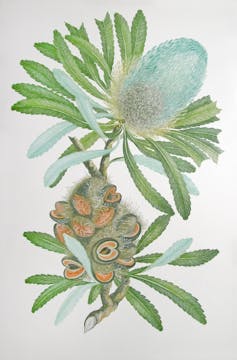reclaiming botany from the tendrils of empire
- Written by Prudence Gibson, Lecturer and researcher in Plant Humanities, UNSW Sydney

The field of plant-humanities includes botany, taxonomy and plant evolution on the one hand, and literature, law and the arts on the other. Recent publications have covered botanical histories, imperialist plant-collecting fervour, queer botany, botanical art and Indigenous methodologies associated with botany, to name just a few.
Review: Botany of Empire: Plant Worlds and the Scientific Legacies of Colonialism – Banu Subramaniam (University of Washington Press)
What comes as a huge relief is a book weaving together these interconnected tendrils, while also blooming with personal anecdotes and even fictional stories.
The author of this new book, Botany of Empire, is Banu Subramaniam, a scholar of feminist science and technology studies at Wellesley College in Massachusetts.
Botanical history and plant-naming
In her new book, Subramaniam presents an argument about the colonial history of science. The discipline of science was set up to serve empire, she reasons, rather than the reverse.
She is thinking about the 17th-19th century period of European empirical expansion into far-flung and soon to be colonised countries like Australia. Rather than seeing the great historical swathe of European curiosity in natural history as an admirable pursuit of scientific knowledge, it can be analysed as an act of political power.
Ships leaving European shores stopped to collect enslaved people, plant specimens and related knowledge (often in West Africa). They then sailed to colonial ports to establish plantations and enslaved settlements.
While in Australia, English botanist Joseph Banks (1743-1820) collected 1,400 plants over his seven-week trip. No Aboriginal plant names were recorded. Plants were then returned to Britain and Europe to meet the growing hunger for rare natural collections. These collections became the major European museums and herbaria we know today, such as Kew Gardens in London.
Subramaniam follows the voyage of botany as a rising science and the way it transposed colonial views onto nature. The natural world was seen as a resource to be controlled or extracted: a never-ending bounty, provided by the grace of God.
This view was reinforced by major botanical figures such as Sweden’s Carl Linnaeus (1707-78), the botanist responsible for current western plant naming and categorising. We still use Linnaeus’s naming system today.
Plant naming is a fractious area of botany, partly because most plants are named after white, western men. Acknowledgement of female and Indigenous plant collectors is often absent from plant names and also from the botanical database records.
This plant naming has erased (and mostly continues to erase) Aboriginal and Torres Strait Islander names for plants within institutions. There are plans among staff at many botanical herbaria collections to attend to this problem by including Indigenous names in their databases. This work is not yet completed.
The task has been made especially difficult because Linnaeus’ system of naming only allows for two Latin names for genus and species (eg. Eucalyptus paniculata), not additional Aboriginal names.
There has been some progress with regard to extreme examples of racist plant names, such as those including the word “caffra,” a slur against black people. A group of international botanists recently voted to remove these racist slurs from herbaria’s botanical names.
A feminist perspective
In Botany of Empire, Subramaniam proposes a “counter-colonial botany” approach, exposing botany’s and colonialism’s co-dependence.
Hers is a feminist perspective, which sees problems with the structures of the disciplines of botany and science. She is not alone. Katherine Yusoff, an English scholar of “inhuman geography” questions the male-dominance and Eurocentric, racist and sexist terminology in the geology field in her book A Billion Black Anthropocenes or None.
Subramaniam says, controversially, that fields such as conservation biology, restoration ecology, and agricultural biotechnology, and places such as museums, botanical gardens, and seed and germplasm banks are “savior sciences and practices that pre-serve the legacies of empire”.
In other words, these disciplines of knowledge and places of collection and research were set up with good intentions – to save, to restore, to conserve. But they are elitist: women, Indigenous peoples and those not in the nobility or educated classes were mostly not afforded the chance to collect, to categorise, to manage or make decisions in these fields.
For instance, Subramaniam notes that Linnaeus had a very odd set of language and terminology around the way plants germinate. By endowing plants with human sexual genitalia, Linnaeus created a sexual vocabulary that hetero-normalised the plant world, deeming it a subset of the human condition.
He projected human sexuality onto plants. This was what we now call colonial botanising – imposing a dominant white, male narrative onto plant stories.
Subramaniam doesn’t mention some of the other taxonomists who named plants. Those overlooked include Catherina Dorrien (1717-95), a mushroom taxonomist, and Scottish taxonomist Robert Brown (1773-1858), a naturalist who joined Matthew Flinders’ southern Australia expedition in 1801.
Experiments with botanical fiction
Subramaniam delves into colonial botany to be more attuned to the plants themselves, rather than being overwhelmed by it as a strict field of study.
This attunement brings us to the more creative elements of her book: interludes she calls “Fables for the Mis-Anthropocene.”
One of her interludes, full of puns, is titled Queer Vegennials (a play on younger, millenial people who are vegetarians and plant-lovers). Her Queer Vegennials are keen to protest on behalf of plants and ask, “Why reduce plants to humans?” They refuse the binary language of botany, reverting to traditional descriptors such as pistils, ovules and seeds.
In addition to these stories, there are first person memoir accounts of the author’s early life in India. I liked hearing Subramaniam had a similar childhood to me, in that she was not taught the truth about our colonial pasts at school. For instance, she was not taught about the pillages of the East India Company. Like those of us educated in 1970-80s Australia, she instead diligently recited English poets such as Wordsworth and Coleridge.





